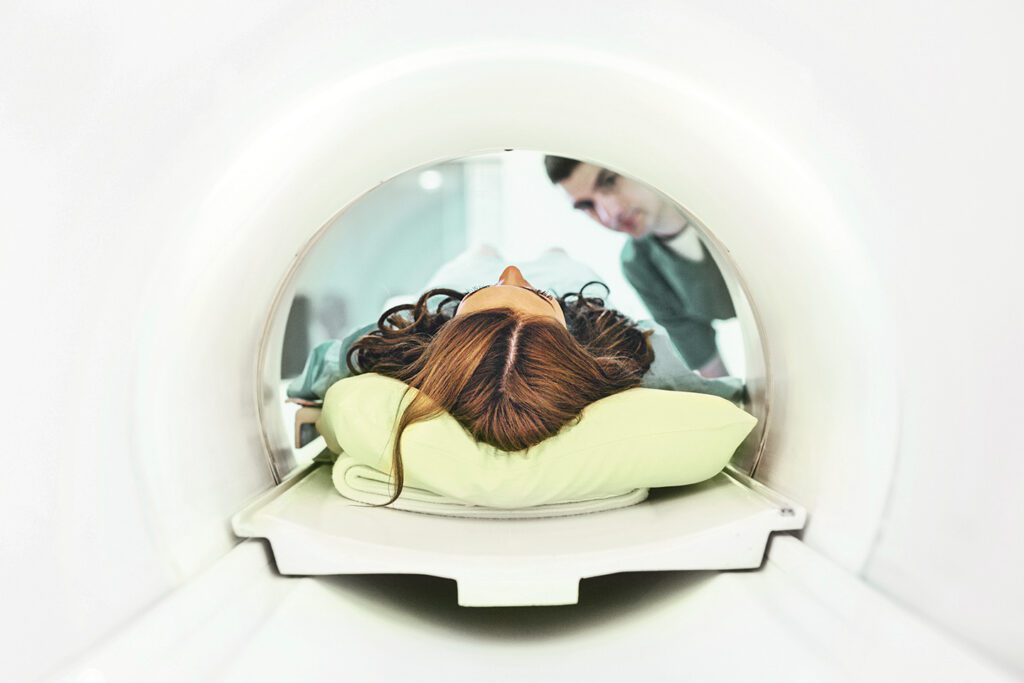For many, hearing the word “aneurysm” automatically summons feelings of fear.
However, there are ways to treat an aneurysm – even before it ruptures in the brain – and understanding the signs that indicate when to seek medical care can help you rest a little easier.


By definition, an aneurysm is a bulge or a ballooning of a blood vessel; its appearance is commonly referred to as “a berry hanging from a stem.” There are a few different types of aneurysms. An aortic aneurysm occurs when a section of the aorta – the body’s largest artery – is permanently dilated to a much larger size than normal, and can occur in either the chest or the abdomen. Aneurysms can also occur in the body’s iliac, femoral, and popliteal arteries; however, the focus of this article is on the cerebral aneurysm, which is more commonly referred to as a brain aneurysm.
A brain aneurysm occurs when the wall of a vessel in the brain weakens, allowing the bulge mentioned above to develop. A medical emergency occurs when this bulge begins to leak or rupture, but many aneurysms remain intact. These unruptured aneurysms can be detected via a CT angiogram, and if they cause little to no symptoms, often are only discovered while someone is being tested for other conditions.
Causes & Risk Factors of Brain Aneurysms
The exact causes of both the brain aneurysm itself and the ruptures that can occur are unfortunately not typically known. “There is usually no specific cause for an aneurysm to rupture,” explains Dr. Peter Boehm, Jr., a neurosurgeon with Erlanger Neurosurgery and Spine. “It can happen at rest or during times of strenuous activity.” However, experts agree that genetics is likely one of the most common causes of an aneurysm. “People are born with a defective vessel wall, that over time, will develop into an aneurysm,” says Dr. Juan Gonzalez, a neurologist with Hamilton Physician Group. “That is why we often will ask if you have first-line relatives with a history of aneurysms.”
Despite exact cause often being a mystery, there are a number of known factors that might elevate your risk of developing an aneurysm. The following are considered risk factors for brain aneurysms:
- cigarette smoking
- alcohol abuse
- illicit substance abuse, particularly cocaine
- older age
- uncontrolled high blood pressure
- brain injury or prior aneurysm rupture
- inherited disorders, such as Ehlers-Danlos syndrome or polycystic kidney disease
Symptoms
The symptoms of an aneurysm vary greatly depending on the stage that the aneurysm is in. An unruptured aneurysm, especially if small in size, may not produce any symptoms, and is often discovered while other tests are being run during a visit to a physician or a specialist. However, there are still some tell-tale signs that may become present. “The symptoms of an unruptured aneurysm range from vague, such as pain behind the eyes, transient facial numbness, and intermittent blurred vision, to specific, such as a dilated pupil, double vision, and new headache onset,” explains Dr. Gonzalez. The vague symptoms listed may often be mistaken for a much less volatile condition, so if you’ve been experiencing them, it’s important to talk with a doctor about them.
A leaking aneurysm, which is an aneurysm that is leaking a small amount of blood but has not yet fully ruptured, typically causes a sudden, very severe headache. This is often a sign of impending rupture, so it’s important to seek medical attention promptly.



A ruptured aneurysm is a medical emergency, and care should be sought immediately. A sudden and extremely severe headache, often referred to as a “thunderclap headache,” is one of the primary symptoms. “It is commonly described as ‘the worst headache of my life’ or ‘like a bomb went off in my head,’’’ explains Dr. Boehm. “It can be associated with vomiting, blurry vision, altered mental status, seizures, and decreased level of consciousness.” Other symptoms associated with a ruptured aneurysm include a stiff neck, sensitivity to light, and a drooping eyelid.
Complications
Though the period of bleeding usually doesn’t last for very long when an aneurysm ruptures, it can cause a direct and severe domino effect of complications. “There is an array of neurological effects that can arise from an aneurysm rupturing,” says Dr. Boehm. “These can range from full recovery to chronic headaches, memory issues, emotional disturbances, visual disturbances, seizures, weakness, paralysis, or stroke, to name a few. Even with a good recovery, patients are often affected in some fashion on a daily basis.”
There are various other medical complications that may arise. For example, an aneurysm that has leaked or fully ruptured is at risk of bleeding again, which can cause added damage to the brain cells. An aneurysm may also cause the blood vessels in your brain to narrow unpredictably (referred to as a vasospasm), which can limit blood flow to brain cells, causing cell damage and/or stroke.
Hydrocephalus can occur when bleeding from the aneurysm blocks circulation of fluid in the brain and spinal cord, which can result in excess spinal fluid that in turn puts too much pressure on the brain, damaging it. The hemorrhaging from an aneurysm can also create an imbalance of sodium in the blood by damaging the hypothalamus (called hyponatremia); this drop in levels of sodium in the blood can cause swelling and permanent damage to the brain as well.
Treatment
Currently, there are two common treatment options for a ruptured brain aneurysm: surgical clipping and endovascular coiling. “To put it simply, clipping is brain surgery that involves snapping a metal clip across the vessel that feeds the aneurysm, and coiling is surgery that involves driving a wire coil from an artery in the groin to the artery in the brain that has the aneurysm,” explains Dr. Gonzalez. “The wire coils up inside the aneurysm, essentially blocking blood from entering that space.”
With surgical clipping, the neurosurgeon removes a portion of the skull to access the vessel that’s feeding the aneurysm and places a very small clip to halt that blood flow. Endovascular coiling is the less invasive of the two procedures, as it is initiated via a catheter inserted into an artery. However, potential risks accompany both types of surgery, and the procedure chosen will depend on the shape and location of the aneurysm, as well as the age and medical history of the patient and their status upon admittance.
As for unruptured aneurysms, both procedures can be employed as a method of treatment; however, depending on a variety of factors, the risks of these procedures might outweigh the benefits, and treatment plans such as medication to lower blood pressure or smoking cessation might be attempted as a first course of action.
Brain aneurysms can be frightening to think about, but there are things that you can do to lower your risk. Consuming a healthy diet, exercising regularly, refraining from smoking or recreational drug use, and working with your doctor to maintain healthy blood pressure levels can all decrease your risk of a rupturing aneurysm.
Brain aneurysms can be frightening to think about, but there are things that you can do to lower your risk. Consuming a healthy diet, exercising regularly, refraining from smoking or recreational drug use, and working with your doctor to maintain healthy blood pressure levels can all decrease your risk of a rupturing aneurysm.



Dr. Peter Boehm, Jr.
Neurosurgeon,
Erlanger Neurosurgery and Spine



Dr. Juan Gonzalez
Neurologist,
Hamilton Physician Group - Neurology

